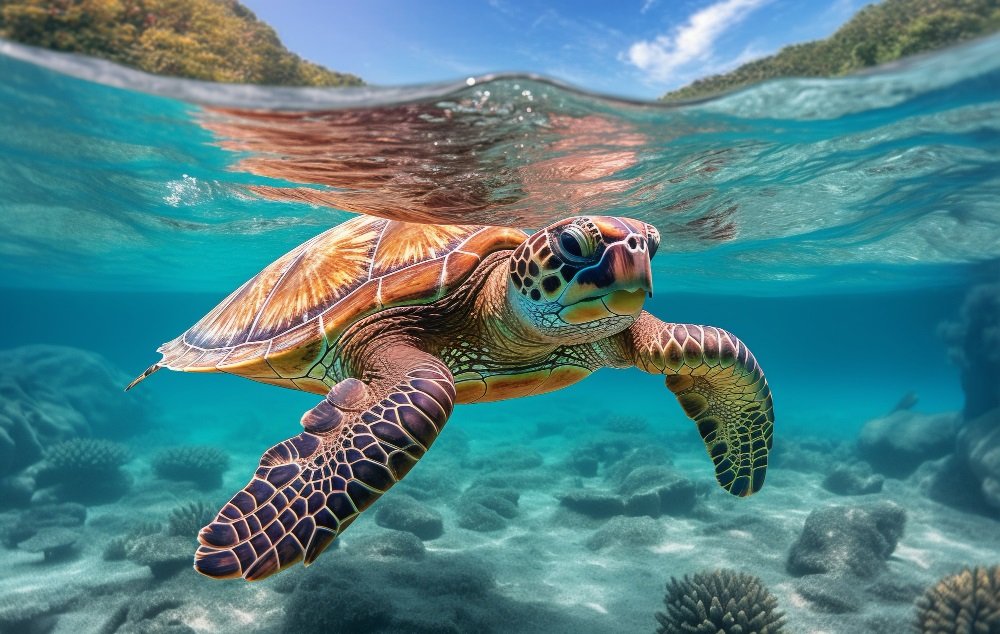Unveiling the evolutionary history of turtles, those ancient and enigmatic reptiles, has fascinated scientists for centuries. Understanding where turtles evolved from provides crucial insights into their unique adaptations, their place within the reptile family tree, and the broader story of life on Earth.
A Journey Through Time: Tracing Turtle Ancestry
Turtles, with their distinctive shells and longevity, are a captivating group of animals. Their evolutionary origins, however, have been shrouded in mystery.
The Shell: A Defining Feature
The turtle’s most iconic feature, its shell, is a complex structure formed from fused ribs and vertebrae, providing exceptional protection. This unique adaptation has played a pivotal role in their survival and diversification, but its evolutionary origins remain a subject of ongoing research.
Fossil Evidence: Clues from the Past
Paleontologists rely on fossil discoveries to piece together the evolutionary history of turtles. Fossils of early turtle ancestors have provided valuable clues, revealing transitional forms and shedding light on the gradual development of key turtle characteristics.
Where Did Turtles Evolve From?
Turtles, with their ancient lineage and distinctive shells, have captivated humans for centuries. Their origins remain a subject of ongoing scientific inquiry, with paleontological discoveries and genetic analyses continually refining our understanding. The evolutionary journey of turtles is a fascinating tale that spans millions of years, revealing a lineage deeply intertwined with the history of life on Earth.
Early Clues and the Mystery of Turtle Origins
The fossil record provides the primary evidence for tracing turtle evolution. Early turtle fossils, dating back to the Triassic period (around 220 million years ago), exhibit many of the characteristics we associate with modern turtles, including their iconic shells. However, these early forms, like Odontochelys semitestacea, possessed teeth, a feature absent in most modern turtles. This suggests that turtles evolved from a lineage of toothed reptiles, but the exact relationship remains a puzzle.
The Search for Ancestral Relatives
Scientists have proposed several hypotheses regarding the turtle’s closest relatives. Some studies suggest a connection to the diapsids, a group that includes archosaurs (dinosaurs and their relatives) and lepidosaurs (lizards and snakes). Others propose a link to the pareiasaurs, a group of herbivorous reptiles that lived during the Permian period. However, definitive evidence to support any single hypothesis is still lacking. (See Also: How Do Turtles Sleep In Water)
Shell Evolution: A Key Adaptation
The turtle’s shell is arguably its most defining feature, providing both protection and support. Its evolution is a remarkable example of adaptation, with the shell originating from modified ribs and vertebrae. The shell consists of two parts: the carapace, which covers the back, and the plastron, which protects the underside.
The Development of the Shell
The evolution of the shell likely occurred gradually over millions of years. Early turtles, like Odontochelys semitestacea, had a partially ossified shell, with bony plates covering their back. Over time, these plates fused together, forming the complete carapace and plastron. The shell’s shape and size also varied depending on the turtle’s environment and lifestyle.
Diversification and Extinction: A History of Change
Throughout their evolutionary history, turtles have diversified into a wide range of forms, inhabiting diverse environments from oceans to deserts. Fossil evidence reveals that turtles have experienced periods of both diversification and extinction.
Major Turtle Lineages
Some of the major turtle lineages include:
- Cryptodira: This group, which includes most modern turtles, retracts its head straight back into its shell.
- Pleurodira: This group, found primarily in the Southern Hemisphere, retracts its head sideways into its shell.
Extinct Turtle Groups
Numerous extinct turtle groups have also been discovered, showcasing the vast diversity that existed in the past. These extinct groups often possessed unique features, such as larger shells, elongated necks, or specialized teeth.
Genetic Insights: Unraveling the Evolutionary Tree
Recent advances in genetic sequencing have provided valuable insights into turtle evolution. By comparing the DNA of different turtle species, scientists can reconstruct their evolutionary relationships and trace their origins. (See Also: Do Box Turtles Bite)
Molecular Clock Dating
Molecular clock dating techniques, which use the rate of genetic mutations to estimate evolutionary timescales, have been used to refine the timeline of turtle evolution. These studies suggest that turtles diverged from their closest relatives around 220 million years ago, during the Triassic period.
Recap and Conclusion
The evolutionary history of turtles is a complex and fascinating story. While the exact origins of turtles remain a subject of ongoing research, fossil evidence and genetic analyses have provided valuable clues. The evolution of the turtle’s iconic shell, its diversification into a wide range of forms, and its remarkable resilience over millions of years make turtles a truly remarkable group of animals.
Future discoveries, including the identification of new fossil species and the advancement of genetic sequencing techniques, will undoubtedly continue to shed light on the enigmatic origins and evolutionary journey of these ancient reptiles.
Frequently Asked Questions About Turtle Evolution
Where did turtles first appear in the fossil record?
Turtles first appeared in the fossil record during the Triassic period, roughly 220 million years ago. Early turtle fossils have been found in what is now China, North America, and Europe.
What are the closest living relatives of turtles?
This is a bit of a scientific debate, but the current consensus is that turtles are most closely related to a group of reptiles called archosaurs. This group includes crocodiles, birds, and dinosaurs. (See Also: When Do Turtles Go Into Hibernation)
How did turtles develop their unique shells?
The evolution of the turtle shell is a fascinating process. Scientists believe that the shell evolved from the ribs and backbone of early turtles, which gradually became fused and covered with bony plates. This provided them with an incredible defense mechanism against predators.
Did turtles evolve from dinosaurs?
While turtles and dinosaurs share a common ancestor, turtles did not evolve directly from dinosaurs. They branched off from the archosaur lineage earlier in evolutionary history.
Are there any living fossils among turtles?
Some turtle species, like the leatherback sea turtle, are considered “living fossils” because they have remained relatively unchanged for millions of years. Their unique adaptations allow them to thrive in their specific environments.



